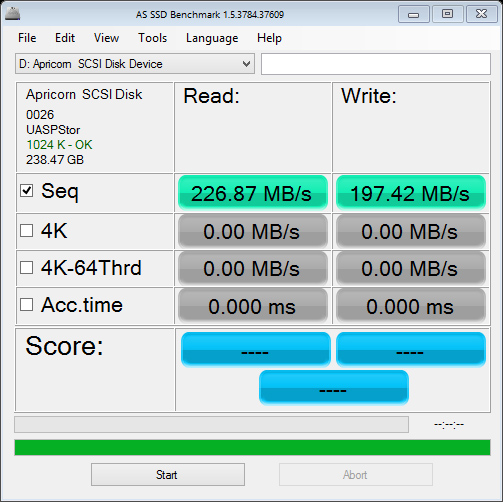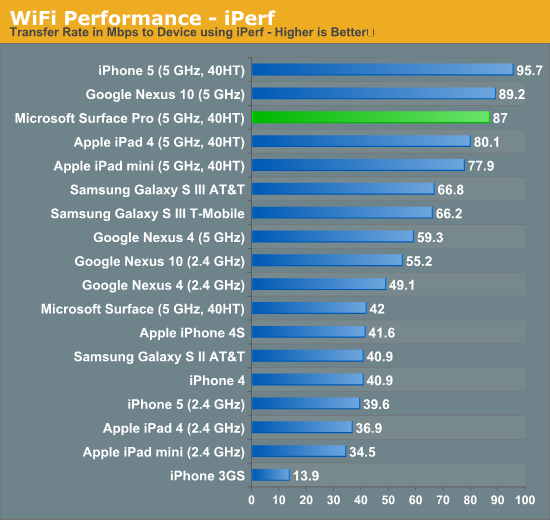Microsoft Surface Pro Review
by Anand Lal Shimpi on February 5, 2013 9:00 PM ESTFans and Thermals
While Surface RT was passively cooled, Surface Pro features two integrated fans to cool the 17W Core i5-3317U. For most light use cases, those two fans will remain spun down and you can’t hear them. Do any sort of serious multitasking or start using Surface Pro as a real PC instead of a tablet and you’ll quickly hear them spin up. Fan noise is audible but not annoying - it’s very similar to the sound you’d hear out of any ultraportable with a couple of tiny fans spinning up.
In landscape mode with the Type Cover attached, Surface Pro draws in cool air from the sides and exhausts it out of the top of the device. Rotate the device into portrait mode and the fans will switch directions, drawing in cool air from the long edge and exhausting it out of the short edges. The fan direction switch is triggered in tandem with display rotation, so as soon as you see your display rotate you’ll hear the fans change direction.
The two fans do a good job keeping the CPU cool (I saw typical CPU core temperatures between 50C - 60C), but Surface Pro does get warm. I measured a max surface temperature of 41.8C while running 3DMark 11. That’s towards the top of the unit, around where the Core i5 CPU is located. On the edges I measured a max surface temperature of 36.5C. There’s no getting around the fact that Surface Pro gets warm, noticeably more so than the 4th generation iPad. It never gets uncomfortably hot however.

Despite being a tablet, the Core i5-3317U had no issues hitting its max turbo frequency of 2.6GHz. I even saw 2.75GHz for a very short period of time (remember, Intel’s Turbo Boost can exceed max TDP until the silicon gets up to temperature).
Storage and USB 3.0
Surface Pro ships with a micro SDXC slot along the edge of the device. Courtesy of Intel’s HM77 chipset, you also get a full blown 6Gbps SSD and a single USB 3.0 port - both significant upgrades over Surface RT. In my 128GB review sample, Surface Pro features a Micron C400 SSD. Microsoft is sourcing from multiple SSD vendors and claims to be shipping with optimized firmware, but I don’t know what other vendors are in the mix. Update: It looks like the C400 SSD is an mSATA drive, likely similar to the one we reviewed here a while back.

To put this in perspective, the C400 is in the same class of storage device that’s used in Apple’s MacBook Air. Although some ARM based SoCs feature SATA interfaces, pretty much all of them are paired with eMMC based NAND storage solutions that are horribly slow. The fastest sequential transfer rates I’ve managed on the 4th generation iPad are typically on the 20 - 30MB/s range, whereas the C400 in the Surface Pro is good for over 400MB/s in reads and just under 200MB/s in writes.

There’s been a lot of debate over the amount of free space available on Windows RT/8 tablets fresh out of the box. My 128GB review sample was partitioned down to 110GB with roughly 8GB used for the recovery partition. Of that 110GB, 89.5GB was free space that remained. I don’t really view this as false advertising by Microsoft (both Macs and PCs have been sold like this for decades), but you do need to know what you’re getting into here. Given the already high price of these systems and the relatively small price differential between a 64GB Surface Pro and a 128GB model, I’d recommend going for the latter. Microsoft claims something like 29GB of free space remains on the 64GB model - enough for some apps and data, but keep in mind like all solid state storage you don’t want to completely fill up your drive either (this is also true for ARM based tablets like the iPad).
USB 3.0 is equally as impressive on Surface Pro. Using a simple USB 3.0 to SATA adapter I could easily read and write at around 200MB/s. Compare this to the ~20MB/s you get on most ARM based tablets and it’s obvious that this Surface deserves its Pro moniker.

Ultimately Surface Pro’s storage subsystem is a big part of what separates it from the current crop of ARM based tablets. While it’s possible to run productivity workloads on many tablets these days, there’s truly very little that separates what you can do on Surface Pro with what what you can do on a conventional PC.
WiFi Performance
Similar to Surface RT, Surface Pro uses a 2x2 802.11n WiFi controller from Marvell. I believe this is likely the same Marvell Avastar 88W8797 WiFi solution, but connected over USB instead of SDIO.
WiFi performance is appreciably better than on Surface RT, connected to a 5GHz 802.11n network I was able to pull a maximum of 87Mbps compared to 42Mbps on Surface RT. This is competitive with what I’ve seen on other high-end tablets based on ARM architectures, although lower than what I’ve gotten out of a MacBook Air.

WiFi range is subjectively really good on Surface Pro and a lot better than most ARM based tablets I’ve played with. I ran an iperf test on an iPad 4 and Surface Pro around 100 feet away from an AP through several walls and saw roughly an order of magnitude better performance out of the Surface Pro (8 - 10Mbps vs. 0.95 Mbps).
While peak WiFi performance out of Surface Pro is similar to a high-end tablet, worst case performance is more like a good notebook. Overall I’m pleased with the wireless stack on Surface Pro.










228 Comments
View All Comments
kyuu - Friday, February 8, 2013 - link
I'm looking to get a mobile device with part of my tax return. I have zero interest in an iOS or Android tablet. What I'm looking at currently:1) Vizio's Hondo-based Tablet PC that was shown at CES.
2) Vizio's 2nd gen thin+lights, 14" model with touch screen and AMD A10
So basically, an ultrabook (thin+light) or a tablet are the only mobile devices I'm interested in. A normal laptop is too heavy and bulky for me to reguarly take with me out of the house. The Surface Pro would be in consideration, but the price is a little higher than I'm willing to spend (and should *really* include one of the covers).
atl - Wednesday, February 6, 2013 - link
42W 2 cell battery means 2 x 6 amps Li-ion cells (probably cut at 90% to increase cycles).As Li-ion charges from 0% to 70% at 1C, it requires 6amp charger.
Supplied charger just doubles the fast-charge period
kawatwo - Thursday, February 7, 2013 - link
Would like to see some Win 8 tablets with Core I3 and weight under 1.5 pounds. 2 pounds is a bit heavy for a tablet. Needs to include the Type keyboard as well. But overall what an awesome device. I'm sure other PC makers will get it right in the not real distant future.jeffkibuule - Friday, February 8, 2013 - link
Acer will have a newer version of the W700 with a 7W SDP Ivy Bridge chip that is 20% thinner than their current model (around 8mm), so it's certainly possible.phillyry - Saturday, February 16, 2013 - link
Graphics would blow on an i3 and make the touch based interface borderline unusable.Sabresiberian - Thursday, February 7, 2013 - link
I think Microsoft got into building their own hardware here because they felt forced to; no one was building the kind of quality device they wanted. I think Nokia and HTC need to step their games up too if they don't want a Microsoft phone to come along and take their business away (or relegate it to the cheap seats). I like this approach, and hope they do kick the phone industry on the pants, because none of them are what I'd really call "good". (I'm talking ALL smart phones, not just Win 8 phones - phones that really don't take much of a back seat to anything else on the market, overall.)THE one thing that kills the Surface for me is the 16:9 screen. that's okay for a tablet I suppose, but the Surface isn't about being "okay", and I think it's a slam in the face of a real quality experience. It puts the iPad out of the picture in every other way (in my opinion), but in this way, the iPad still pretty much kills everyone else.
Netscorer - Thursday, February 7, 2013 - link
Nobody else is building these because there is not enough demand. Microsoft can afford to chuck up all the costs that gone into Surface as marketing for Windows 8 OS, but if you are a typical PC manufacturer who operates on razor thin margins, you won't be able to afford to do what it takes to create an iPad killer. Add to this that neither Intel, nor Microsoft are giving you much of a slack on prices for core and Windows and that market for $1000+ laptops is already very small to begin with and you get the picture.SilthDraeth - Thursday, February 7, 2013 - link
I know it was a windows 7 tablet, but it to runs on a core i5 and 2gb of RAM. Have you guys never bench marked it, to include it in the graphs, in comparison to the newest?Silma - Thursday, February 7, 2013 - link
While it is perfectly clear to me that with a much bigger processor power consuption will be bigger than a way slower arm, hence it is to be expected that ultrabooks/surfaces can't have the same battery life as an iPad or nexus tablet, I don't understand the extreme différences seen in video playback benchmarks.On this benchmark I would of course expect Windows 8 offering to use a little more power than on an ios / android tablet due to the overhead of a bigger os, but here the différences are huge.
Here I think Microsoft and Intel could optimize greatly the power usage for 720p and 1080p mp4 playback.
andrewaggb - Thursday, February 7, 2013 - link
Agreed.